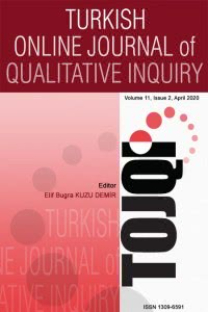Investigating Pre-service Mathematics Teachers’ Geometric Problem Solving Process in Dynamic Geometry Environment
Investigating Pre-service Mathematics Teachers’ Geometric Problem Solving Process in Dynamic Geometry Environment
The aim of this study is to investigate pre-service elementary mathematics teachers’ open geometric problem solving process in a Dynamic Geometry Environment. With its qualitative inquiry based research design employed, the participants of the study are three pre-service teachers from 4th graders of the Department of Elementary Mathematics Teaching. In this study, clinical interviews, screencaptures of the problem solving process in the Cabri Geomery Environment, and worksheets included 2 open geometry problems have been used to collect the data. It has been investigated that all the participants passed through similar recursive phases as construction, exploration, conjecture, validate, and justification in the problem solving process. It has been thought that this study provide a new point of view to curriculum developers, teachers and researchers
___
- Arsac, G., & Mante, M. (1983). Des problemes ouverts dans nos classes de premier cycle, Petit x, 2, pp.5-33. Retrieved October 13, 2012 from http://www-irem.ujf-grenoble.fr/revues/ revue_x/fic/2/2x1.pdf .
- Arsac, G., Germain, G., & Mante, M. (1988). Problème ouvert et situation-problème, IREM, Villeurbanne.
- Bağcivan, B. (2005). İlköğretim yedinci sınıflarda bilgisayar destekli geometri öğretimi. Yayınlanmamış Yüksek Lisans Tezi. Bursa: Uludağ Üniversitesi Sosyal Bilimler Enstitüsü.
- Bintaş, J., Ceylan, B., & Dönmez, O. (2006). Dinamik geometri yazılımları aracılığıyla ispat yoluyla öğrenme, Eğitimde Çağdaş Yönelimler–3 Yapılandırmacılık ve Eğitime Yansımaları Çalıştayı (29 Nisan 2006). İzmir: Tevfik Fikret Okulları.
- Cai, J., & Hwang, S. (2002). Generalized and generative thinking in U.S. and Chinese students’ mathematical problem solving and problem posing. Journal of Mathematical Behavior, 21(4), 401-421.
- Çepni, S. (2007). Araştırma ve proje çalışmalarına giriş (3. Baskı). Trabzon: Celepler Matbaacılık. (MEB, 2005).
- Chazan, D. (1993). High school geometry students’ justification for their views of empirical evidence and mathematical proof. Educational Studies in Mathematics, 24, 359–387.
- Christou , C., Mousoulides, N., Pittalis, M., & Pitta-Pantazi, D. (2004). Proofs through Exploration in dynamic geometry environments. International Journal of Science and Mathematics Education (2004) 2: 339–352.
- Christou, C., Mousoulides, N., Pittalis, M., & Pitta-Pantazi, D. (2005). Problem solving and problem posing in a dynamic geometry environment. The Montana Mathematics Enthusiast (TMME), 2(2), 125-143.
- Clement, J. (2000) Analysis of clinical interviews: Foundations and model viability. In Lesh, R. and Kelly, A., Handbook of research methodologies for science and mathematics education (pp. 341-385). Hillsdale, NJ: Lawrence Erlbaum.
- De Villiers, M. (2004). The role and function of quasi-empirical methods in mathematics, Canadian Journal of Science, Mathematics and TechnologyEducation, 4 (3),pp. 397–418.
- Edwards, L. (1997). Exploring the territory before proof: Students' generalizations in a computer microworld for transformation geometry. International Journal of Computers for Mathematical Learning, 2, pp. 187-215.
- Furinghetti, F., & Paola, D. (2003). To produce conjectures and to prove them within a dynamic geometry environment: a case study, In Proceeding of Psychology of Mathematics 27th international Conference, 397-404.
- Goldenberg, E. P. & Cuoco, A. A. (1998). What is dynamic geometry? In R. Lehrer and D. Chazan (Eds.). Designing Learning Environments for Developing Understanding of Geometry and Space (pp. 351-368). Lawrence Erlbaum, Mahwah: USA.
- Güven, B., & Karataş, İ. (2003). Dinamik geometri yazılımı cabri ile geometri öğrenme: Öğrenci görüşleri. The Turkish Online Journal of Educational Technology – TOJET, 2 (2).
- Healy, L. & Hoyles, C. (2001). Software tools for geometrical problem solving: Potentials and pitfalls. International Journal of Computers for Mathematical Learning, 6, pp. 235–256.
- Jones, K., (2000). Providing a foundation for deductive reasoning: Students' interpretations when using Dynamic Geometry Software and their evolving mathematical explanations, Educational Studies in Mathematics, Vol. 44, No. 1/2, Proof in Dynamic Geometry Environments. (2000), pp. 55-85.
- Karataş, İ., & Güven, B. (2008). Bilgisayar donanımlı ortamlarda matematik öğrenme: Öğretmen adaylarının kazanımları. 8th International Educational Technology Conference (pp.529-534). Eskişehir: Anadolu University.
- Köse, N. Y., & A. Özdaş (2009). İlköğretim 5. sınıf öğrencileri geometrik şekillerdeki simetri doğrularını cabri geometri yazılımı yardımıyla nasıl belirliyorlar? İlköğretim-Online, 8(1), 159-175.
- Laborde, C. (2000). Dynamical geometry environments as a source of rich learning contexts for the complex activity of proving, Educational Studies in Mathematics, vol. 44/1-2, Kluwer Academic Publisher.
- Leung, A., & Or, C. M. (2007). From construction to proof: Explanations in dynamic geometry environment. In (Eds.) Woo, J. H., Lew, H. C., Park, K. S. & Seo, D. Y. Proceedings of the 31st Conference of the International Group for the Psychology of Mathematics Education, Vol. 3, pp. 177-184. Seoul: PME.
- Lincoln, Y. S., & Guba, E.G. (1985). Naturalistic inquiry. California: Sage.
- Marrades, R., & Gutiérrez, A. (2000). Proofs produced by secondary school students learning geometry in a dynamic computer environment. Educational Studies in Mathematics, 44, pp. 87-125.
- Miles, M., & Huberman, A. (1994). Qualitative data analysis (2nd Edition). London: Sage Publications.
- Mogetta, C., Olivero, F., & Jones K. (1999). Designing dynamic geometry tasks that support the proving process, Proceedings of the British Society for Research into Learning Mathematics, 19 (3), 97-102.
- Olivero, F., & Sutherland, R. (2000). The churchill cabri project: Background and overview. Rowland, T. (Ed.) Proceedings of the British Society for Research into Learning Mathematics ,20 (3).
- Olivero, F. (2001). Conjecturing in open geometric situations using dynamic geometry: An exploratory classroom experiment, Research in Mathematics Education,3(1), pp. 229-246.
- Or, M. C. (2005). Experimentation, Construction, Conjecturing and Explanation in A Dynamic Geometry Environment. Unpublished Master’s Thesis, University of Hong Kong.
- Scher, D. P. (2002). Students’ conceptions of geometry in a dynamic geometry software environment. Unpublished Doctoral Thesis, New York University, School of Education.
- Straesser, R. (2001). Cabri-geometre: Does Dynamic Geometry Software (DGS) change geometry and its teaching and learning?, International Journal of Computers for Mathematical Learning, Vol. 6, pp.319-333.
- Van De Walle, J. A. (2004). Elementary and middle school mathematics. (5th Edition). Boston: Allyn and Bacon.
- Yin, R. (1994). Case study research: Design and methods. Sage: USA.
- ISSN: 1309-6591
- Yayın Aralığı: 4
- Başlangıç: 2010
- Yayıncı: Prof.Dr. Abdullah Kuzu
